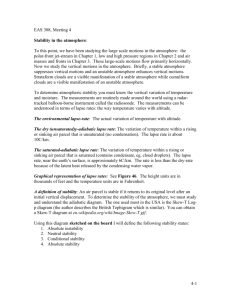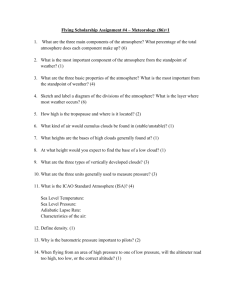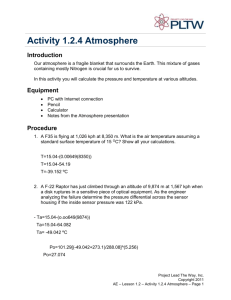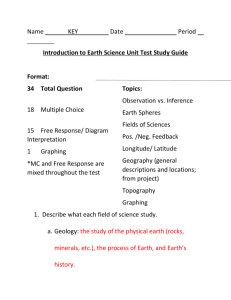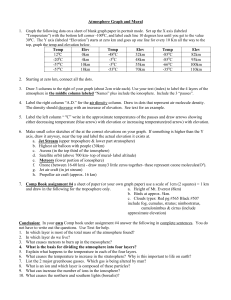Temperature Tendency
advertisement
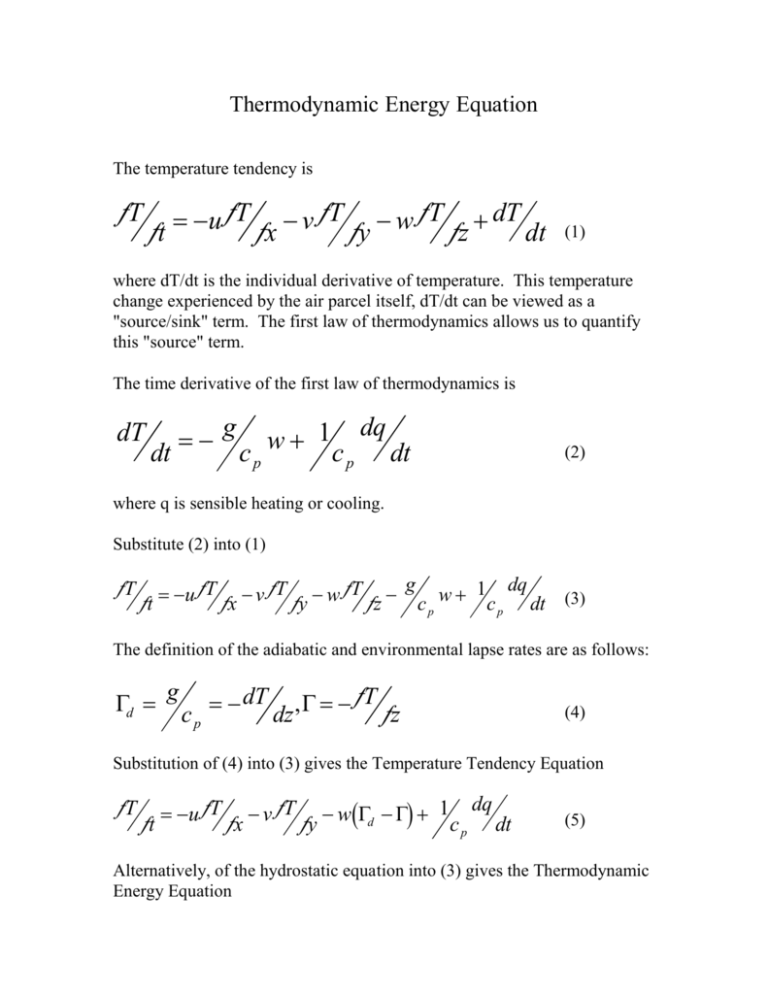
Thermodynamic Energy Equation The temperature tendency is ¶T ¶T - v ¶T - w ¶T + dT = -u ¶t ¶x ¶y ¶z dt (1) where dT/dt is the individual derivative of temperature. This temperature change experienced by the air parcel itself, dT/dt can be viewed as a "source/sink" term. The first law of thermodynamics allows us to quantify this "source" term. The time derivative of the first law of thermodynamics is dT g w + 1 dq = dt cp c p dt (2) where q is sensible heating or cooling. Substitute (2) into (1) ¶T ¶T - v ¶T - w ¶T - g w + 1 dq = -u ¶t ¶x ¶y ¶z cp c p dt (3) The definition of the adiabatic and environmental lapse rates are as follows: Gd = g c = - dT dz ,G = -¶T ¶z p (4) Substitution of (4) into (3) gives the Temperature Tendency Equation ¶T ¶T - v ¶T - w(G - G) + 1 dq = -u d ¶t ¶x ¶y c p dt (5) Alternatively, of the hydrostatic equation into (3) gives the Thermodynamic Energy Equation ¶T ¶T - v ¶T + w æç dT - ¶T ö÷ + 1 dq = -u ¶t ¶x ¶y è dp ¶pø c p dt (6) as is given as equation (4.3.4) in Bluestein except with the term /cp for dT/dp. Static Stability Parameter Setting (5) equal to (6) gives: æ dT ¶T ö -w ( G d - G ) = w ç - ÷ è dp ¶ p ø (7a) Substitution of the relation between omega and vertical velocity gives æ dT ¶T ö w ( G d - G) » -r gw ç - ÷ è dp ¶ p ø (7b) Rearranging terms gives the static stability parameter ( G d - G) = æ dT - ¶T ö = s rg ç è dp (8) ÷ ¶pø For a stable atmosphere, the dry adiabatic lapse rate always exceeds the environmental lapse rate, and the static stability parameter is > 0. Equation (6) may now be rewritten 2 ¶T ¶ t = -u ¶T ¶x - v ¶T 1 dq ¶ y + ws + c p dt (9) Poisson’s Relation is æ 1000 ö Q=Tç ÷ è p ø R Cp (10) Taking the natural log of both sides gives ln ln T R ln1000 ln p Cp (11a,b) Cp ln Cp ln T R ln1000 R lnp The partial derivative with respect to height of (11b) is Cp ¶ ( lnQ) ¶ z = Cp ¶ ( lnT ) ¶z + R ¶ ( ln1000) ¶z - R ¶ ( ln p) ¶z (12) Remembering that (ln x) x x (13) and substituting the gas law and the hydrostatic equation gives 3 C p ¶Q C p ¶T R ¶p = Q ¶z T ¶z p ¶z T ¶Q ¶T R T ¶p = Q ¶z ¶z r C p ¶z (14a,b) Rearranging terms and using the definition for the lapse rates gives T ¶Q ¶ T g = = (-G + G d ) = ( G d - G) Q ¶ z ¶ z Cp - T ¶Q ( G d - G) = =s Q ¶p rg (15a,b) Equation (15b) states that the static stability is greatest in situations in which the vertical gradient of isentropes is the greatest, that is to say, situations in which there is a large change in potential temperature with height. Thus, isentropes are packed in frontal zones, inversions and in the stratosphere, whereas, they are not in regions in which the atmosphere tends toward low static stability. For a stable atmosphere, the static stability parameter is always positive. In the restrictive and rare case of absolutely unstable conditions, the parameter is negative. For a positive static stability parameter, parcels displaced from an initial elevation will be colder and denser than their surroundings at a given elevation. If the parcel is displaced and released, it will oscillate around its initial elevation until it comes to rest. The period (or frequency) of these oscillations can be appears in the double integration of the vertical equation of motion and obtaining a solution for the height, z. dw 1¶p = -g dt r ¶z (16) Using the gas law and the definition of potential temperature d2z g ¶Q =2 dt Q ¶z (17) 4 Notice that the right hand side of equation (17) contains a factor proportional to the static stability parameter, asi n (15a). The solution is in the form of an exponential function, with a power that contains the vertical derivative of potential temperature, as in equations (14a and 15a). (18) where z’ is the final elevation of oscillation, z’o is the initial elevation of the air parcel and N is known as the Brunt-Vaisala frequency, given by the expression: N= g ¶Q Q ¶z (19) Larger values of N occur for highly stable atmospheres and vice versa. N often appears in equations involving instabilities in the atmosphere. The student should keep in mind that the Brunt-Vaisala Frequency is simply another measure of the static stability. Equation (19) conceptually says that the more stable the atmosphere the smaller (and quicker) the oscillations. 5


